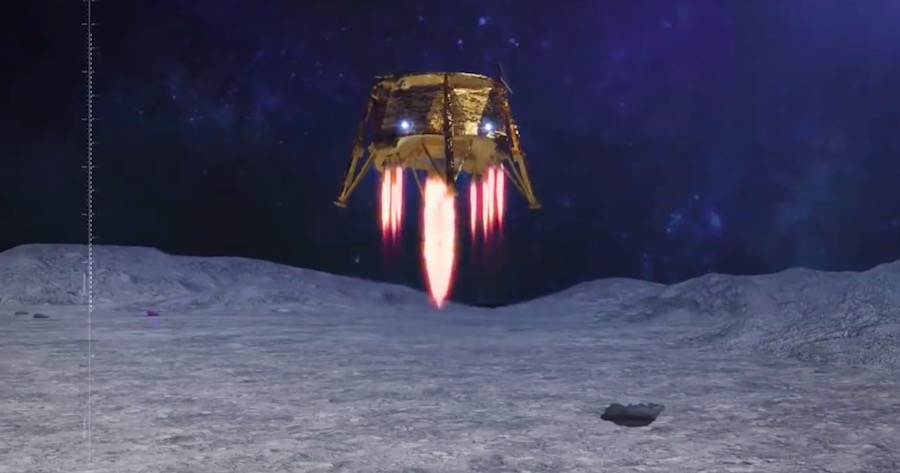
An Israeli-built spacecraft seeking to become the first privately-developed probe to land on the Moon crashed on descent Thursday, but the mission was widely lauded as a breakthrough for the commercial space industry, and Israeli prime minster Benjamin Netanyahu said the country would try again.
“We had a failure of the spacecraft,” said Opher Doron, general manager of the space division at Israel Aerospace Industries, which built the Beresheet Moon lander. “We unfortunately have not managed to land successfully.
“We are the seventh country to orbit the Moon, and the fourth to reach the moon’s surface, and it’s a tremendous achievement up to now,” Doron said.
Live telemetry from the Beresheet spacecraft, relayed to mission control in Yehud, Israel, through a NASA tracking antenna in Spain, indicated the lander ran into trouble around 1919 GMT (3:19 p.m. EDT), six minutes before its scheduled landing time, at an altitude of around 43,800 feet (13,350 meters).
Doron provided updates on the progress of Beresheet’s descent. Data from the spacecraft — about the size of a golf cart — indicated a problem in one of its inertial measurement units, a key part of the probe’s guidance system, Doron said.
Controllers briefly lost the signal from Beresheet, and when they regained telemetry, the data indicated Beresheet was rapidly falling toward the moon.
“We seem to have a problem with our main engine,” Doron said. “We are resetting the spacecraft to try to enable the engine.”
Moments later, a data display in mission control suggested Beresheet had crashed on the lunar surface at high speed at roughly 1923 GMT (3:23 p.m. EDT).
“Well, we didn’t make it, but we definitely tried, and I think that the achievement of getting to where we got is really tremendous,” said Morris Kahn, the president of SpaceIL who donated some $40 million of his fortune to the privately-funded lunar lander program. “I think we can be proud.”

“If at first you don’t succeed, you try again,” said Israeli prime minister Benjamin Netanyahu, who observed the landing attempt from the control center.
Netanyahu said Israel could try to another moon landing mission in two years.
Beresheet began its descent at an altitude of about 15 miles (25 kilometers), roughly 500 miles (800 kilometers) from its targeted landing site, a few hundred kilometers from the location where the Apollo 15 astronauts landed in 1971.
The lander first switched on its laser landing sensors, which were designed to feed data about the craft’s altitude and descent rate to a guidance computer responsible for commanding firings of Beresheet’s main engine to control its speed.
Then Beresheet began pulsing its eight small control thrusters to get into the correct orientation to slow its speed and fall toward the moon, with its main engine facing in the direction of travel parallel to the lunar surface.
Beresheet’s main engine was a 100-pound-thrust (400-newton) LEROS 2b engine built by Nammo, formerly Moog, in the United Kingdom. The hydrazine-fueled engine was a modified version of a thruster typically used by large communications satellites.
But the engine had never been used for a landing on another planetary body, and engineers updated the engine’s design to allow for multiple “hot restarts,” when the lander will fire the engine in quick bursts to control its descent rate. The engine couldn’t be throttled to adjust Beresheet’s speed.
“The hot restarts represented a particular challenge as it effectively puts the engine into its most stressful temperature environment,” said Robert Westcott, one of Nammo’s lead propulsion engineers on the Beresheet project, before Thursday’s landing attempt. “To test this we performed a series of hotfire trials together with SpaceIL, where we stopped and started the engine repeatedly, which confirmed that it is able to operate in this highly demanding firing mode.”
Other changes to the engine included shortening its nozzle to ensure it could fit into the Beresheet spacecraft and keep the thruster from hitting the Moon’s surface. Nammo also made the engine more powerful for Beresheet by increasing its thrust.
Data transmitted back to Earth from the spacecraft showed Beresheet started slowing its speed above the moon from roughly 3,800 mph (1.7 kilometers per second) around 1911 GMT (3:11 p.m. EDT).
If the spacecraft performed as expected, Beresheet should have reached a horizontal velocity of zero at an altitude of about 3,300 feet (1 kilometer). Beresheet would have then pitched over and started a vertical descent.
“Roughly 15 feet (5 meters) or so above the surface of the Moon, the velocity will go to zero, and then we’ll just shut off the motors and the spacecraft will perform a free fall all the way to the surface of the Moon,” said Yariv Bash, a SpaceIL co-founder, last week. “The legs of the spacecraft were designed to sustain that fall, and hopefully once we are on the Moon we’ll be able to send back images and videos to Earth.”
After settling on the surface on its four landing legs, Beresheet was to take a series of pictures, including images for a panorama to show the probe’s surroundings. The lander was also be programmed to record a series of images during the landing sequence to create a video of the descent.
Beresheet’s sole active science instrument was a magnetometer developed by the Weizmann Institute of Science in Israel to measure the magnetism of lunar rocks.
The German space agency — DLR — also helped the SpaceIL team with drop testing to simulate the conditions the spacecraft will encounter at the moment of landing.
Despite landing failure, officials laud Beresheet’s groundbreaking mission
Beresheet, which means “genesis” or “in the beginning” in Hebrew, was aiming to become the first privately-funded spacecraft to land on another planetary body. The mission was developed for around $100 million by SpaceIL, a non-profit organization founded in 2011 by three young Israeli engineers.
Despite the probe’s failure, officials from NASA and the commercial space industry congratulated the Beresheet team for their achievement in getting the spacecraft so close to landing.
“While NASA regrets the end of the SpaceIL mission without a successful lunar landing of the Beresheet lander, we congratulate SpaceIL, the Israel Aerospace Industries and the state of Israel on the incredible accomplishment of sending the first privately funded mission into lunar orbit,” NASA Administrator Jim Bridenstine said in a statement.
“Every attempt to reach new milestones holds opportunities for us to learn, adjust and progress,” Bridenstine said. “I have no doubt that Israel and SpaceIL will continue to explore and I look forward to celebrating their future achievements.”
Thomas Zurbuchen, head of NASA’s science mission directorate, tweeted: “Space is hard, but worth the risks. If we succeeded every time, there would be no reward. It’s when we keep trying that we inspire others and achieve greatness.”
Zurbuchen said he will travel to Israel later this year for discussions on future cooperation on lunar missions. NASA provided a laser retroreflector and communications and tracking support for the Beresheet mission.

“I want to thank @TeamSpaceIL for doing this landing with millions watching around the world, despite knowing the risks,” Zurbuchen tweeted. “We do the same because we believe in the value of worldwide exploration and inspiration. We encourage all international and commercial explorers to do the same!”
SpaceIL was founded to pursue the Google Lunar X Prize, which promised $20 million grand prize for the first team to land a privately-funded spacecraft on the moon, return high-definition imagery, and demonstrate mobility on the lunar surface.
The Google Lunar X Prize contest ended last year without a winner, but Beresheet’s backers kept the mission alive.
Kahn, a South African-born Israeli businessman, was the mission’s largest single contributor. Other donors included Miriam and Sheldon Adelson, a casino and resort magnate who lives in Las Vegas. IAI, the lander’s prime contractor, also invested some of its own internal research and development money into the program.
The Israeli Space Agency awarded SpaceIL around $2 million, the program’s only government funding.
The X Prize Foundation, which organized the original Google Lunar X Prize competition, announced March 28 that it would offer a $1 million “Moonshot Award” to SpaceIL if the Beresheet mission successfully landed on the moon.
Peter Diamandis, founder and executive chairman of the X Prize Foundation, announced Thursday that SpaceIL will get the $1 million Moonshot Award anyway. He tweeted that the award will help SpaceIL “continue their work and pursue Beresheet 2.0.”
“They managed to touch the surface of the Moon, and that’s what we were looking for for our Moonshot Award,” said Anousheh Ansari, CEO of the X Prize Foundation.
“Besides touching the surface of the Moon, they touched the lives and the hearts of an entire nation, the entire world,” Diamandis said. “These prizes are not easy, and frankly, space is not easy, not yet,” Diamandis said.
Email the author.
Follow Stephen Clark on Twitter: @StephenClark1.



